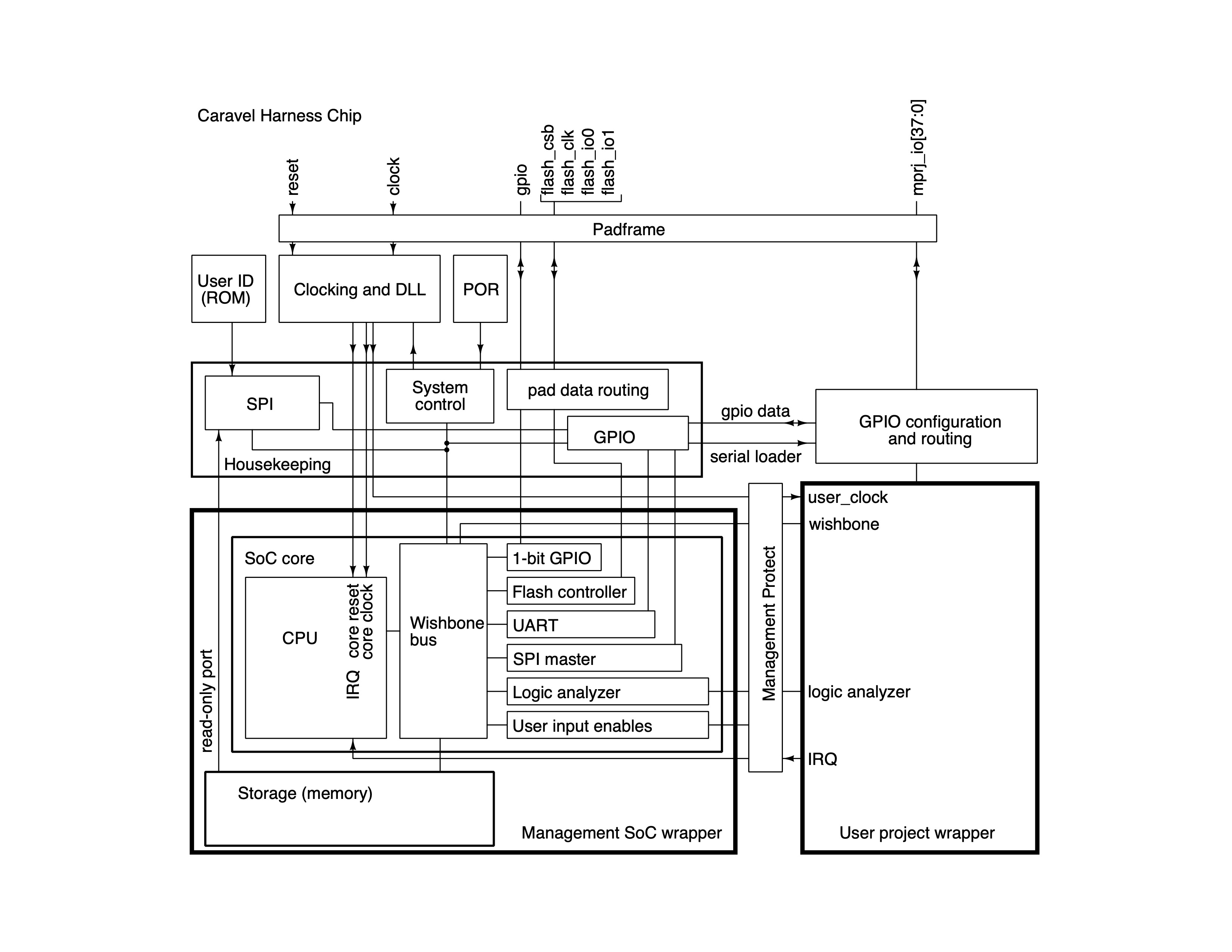NOTE:
Documentation for this project is being updated to reflect the changes for the new redesigned version of Caravel.
- Overview
- Caravel Architecture
- Quick Start for User Projects
- Required Directory Structure
- Additional Material
Caravel is a template SoC for Efabless Open MPW and chipIgnite shuttles based on the Sky130 node from SkyWater Technologies. The current SoC architecture is given below.
Datasheet and detailed documentation exist here
Caravel is composed of the harness frame plus two wrappers for drop-in modules for the management area and user project area.
The harness itself contains the clocking module, DLL, user ID, housekeeping SPI, POR, and GPIO control.
GPIO handling moved out of management SoC and into SPI. SPI gets a wishbone interface; the management SoC talks to the SPI through wishbone, not by taking over the 4-pin SPI interface.
A new block like the ID has the mode at power-up for each GPIO. Can be configured with a text file. SPI pins are fixed for operation on startup.
On power-up, the SPI automatically configures the GPIO. Manual load is possible from both the SPI and from the wishbone bus.
All functions within the harness but outside the management SoC are incorporated into one large module called "housekeeping". This includes a number of registers for all the included functions, with a "front door" SPI interface connected to the padframe through GPIO pins 1 to 4, and a "back door" wishbone interface connected to the management SoC. The management Soc reserves the memory block at 0x26000000 for the housekeeping module. The housekeeping module exchanges data with the management SoC via an interface that uses the byte- wide SPI register data. A small state machine reads four contiguous wishbone addresses and an address decoder determines the corresponding SPI register. The state machine stalls the SoC until all four bytes have been handled before returning the acknowledge signal.
The management area is a drop-in module implemented as a separate repo. It typically includes a RISC-V based SoC that includes a number of peripherals like timers, uart, and gpio. The management area runs firmware that can be used to:
- Configure User Project I/O pads
- Observe and control User Project signals (through on-chip logic analyzer probes)
- Control the User Project power supply
The management area implements SRAM for the management SoC.
The default instantiation for the management core can be found here . See documentation of the management core for further details.
This is the user space. It has a limited silicon area 2.92mm x 3.52mm as well as a fixed number of I/O pads 38 and power pads 4.
The user space has access to the following utilities provided by the management SoC:
38IO Ports128Logic analyzer probes- Wishbone port connection to the management SoC wishbone bus.
Your area is the full user space, so feel free to add your
project there or create a different macro and harden it separately then
insert it into the user_project_wrapper for digital projects or insert it
into user_project_analog_wrapper for analog projects.
If you are building a digital project for the user space, check a sample project at caravel_user_project.
If you will use OpenLANE to harden your design, go through the instructions in this README.
Digital user projects should adhere the following requirements:
- Top module is named
user_project_wrapper - The
user_project_wrapperadheres to the pin order defined at Digital Wrapper Pin Order. - The
user_project_wrapperadheres to the fixed design configurations at Digital Wrapper Fixed Configuration. - The user project repository adheres to the Required Directory Structure.
If you are building an analog project for the user space, check a sample project at caravel_user_project_analog.
Analog user projects should adhere the following requirements:
- Top module is named
user_analog_project_wrapper - The
user_analog_project_wrapperuses the empty analog wrapper. - The
user_analog_project_wrapperadheres to the same pin order and placement of the empty analog wrapper.
Please make sure to run make compress before committing anything to
your repository. Avoid having 2 versions of the
gds/user_project_wrapper.gds one compressed and the
other not compressed.
For information on tooling and versioning, please refer to tool-versioning.rst.
gds/: includes all the gds files used or produced from the project.def: includes all the def files used or produced from the project.lef/: includes all the lef files used or produced from the project.mag/: includes all the mag files used or produced from the project.maglef: includes all the maglef files used or produced from the project.spi/lvs/: includes all the spice files used or produced from the project.verilog/dv: includes all the simulation test benches and how to run them.verilog/gl/: includes all the synthesized/elaborated netlists.verilog/rtl: includes all the Verilog RTLs and source files.openlane/<macro>/: includes all configuration files used to run openlane on your project.info.yaml: includes all the info required in this example. Please make sure that you are pointing to an elaborated caravel netlist as well as a synthesized gate-level-netlist for the user_project_wrapper
NOTE:
If you're using openlane to harden your design, theverilog/gldef/lef/gds/magmaglefdirectories should be automatically populated by openlane.
- Caravel Legacy Repo (previous version used for MPW-ONE)
- Caravel User Project Features -- What are the utilities provided by caravel to the user project ?
- Aboard Caravel -- How to integrate your design with Caravel?
- Things to Clarify About Caravel -- What versions to use with Caravel?
- 45 Chips in 30 Days: Open Source ASIC at its best!
Check mpw-one-final for the caravel used for the mpw-one tapeout.
> make ship is no longer required.

